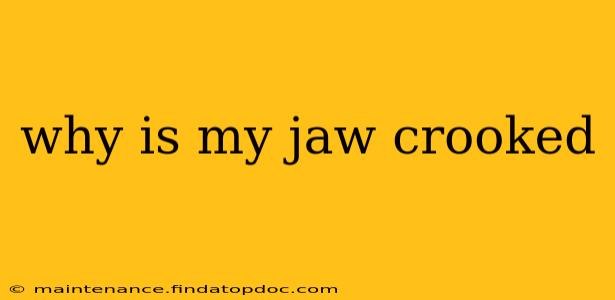A crooked jaw, or mandibular asymmetry, is a more common issue than many realize. It can range from barely noticeable to significantly impacting facial appearance and even causing functional problems. While some cases are purely cosmetic, others can stem from underlying conditions requiring medical attention. Let's explore the possible reasons why your jaw might appear crooked.
What Causes a Crooked Jaw?
Several factors can contribute to a crooked jawline. These can be developmental, genetic, or acquired through injury or other means.
1. Genetics and Developmental Factors
- Genetic predisposition: In many instances, a crooked jaw is simply inherited. Family history of facial asymmetry is a strong indicator. The genes influencing bone growth and development can lead to uneven growth of the jawbones (maxilla and mandible).
- Congenital conditions: Certain birth defects can affect jaw development, resulting in asymmetry. These conditions might involve the temporomandibular joint (TMJ), the hinge connecting the jawbone to the skull.
- Uneven growth patterns: Even without a specific condition, uneven growth during childhood and adolescence can lead to a crooked jawline. This can be influenced by hormonal changes and other factors affecting bone development.
2. Acquired Causes
- Trauma: A significant blow to the jaw, such as a fracture or dislocation, can cause misalignment. Improper healing after such an injury can exacerbate the crookedness.
- TMJ disorders: Temporomandibular joint disorders (TMDs) can affect the position and movement of the jaw, potentially leading to asymmetry. This can manifest as jaw pain, clicking, or locking, along with a noticeable crookedness.
- Habitual actions: Certain habits like chewing on one side of the mouth consistently or grinding teeth (bruxism) can over time influence jaw bone development and lead to asymmetry.
- Infections: Severe infections in the jaw area can lead to bone damage and subsequent asymmetry.
- Tumors: Rarely, tumors or cysts in the jaw can cause asymmetry as they grow and disrupt bone structure.
How Is a Crooked Jaw Diagnosed?
Diagnosing the cause of a crooked jaw typically involves a thorough examination by a dentist or oral surgeon. They will likely ask about your medical history, including any family history of jaw problems or previous injuries. Diagnostic tools might include:
- Physical examination: A visual inspection of the jawline and surrounding areas.
- Imaging studies: X-rays, CT scans, or MRI scans to assess bone structure, TMJ health, and rule out any underlying conditions.
- Assessment of jaw function: The professional will assess how easily and smoothly your jaw opens and closes.
What Are the Treatment Options for a Crooked Jaw?
Treatment options for a crooked jaw depend on the underlying cause and severity of the asymmetry. Some options include:
- Observation: In cases of mild asymmetry with no functional issues, observation might be the recommended approach, particularly if the patient is still growing.
- Orthodontic treatment (braces): Braces can help correct mild to moderate jaw misalignments in growing individuals.
- Orthognathic surgery: This is a surgical procedure to realign the jawbones. It's typically reserved for more severe cases of asymmetry that cause functional problems or significantly impact facial aesthetics.
- Physical therapy (for TMJ disorders): Physical therapy can help manage pain and improve jaw function in cases of TMJ disorders contributing to asymmetry.
Can a Crooked Jaw Be Prevented?
While some causes of a crooked jaw are unavoidable, certain steps can be taken to minimize the risk of developing asymmetry:
- Treat jaw injuries promptly: Seeking medical attention immediately after a jaw injury is crucial to ensure proper healing.
- Maintain good oral hygiene: Good oral hygiene habits reduce the risk of infections that can affect jaw bone health.
- Avoid habits like grinding teeth: Addressing bruxism or other habitual actions can minimize their impact on jaw alignment.
Does a Crooked Jaw Affect My Health?
For many, a crooked jaw is primarily a cosmetic concern. However, in some cases, it can be associated with:
- TMJ disorders: Pain, clicking, and limited jaw movement.
- Difficulty chewing or speaking: In severe cases, asymmetry can affect eating and speech.
- Chronic headaches or facial pain: Sometimes linked to TMJ dysfunction.
Remember, this information is for educational purposes only and does not constitute medical advice. If you are concerned about a crooked jaw, it's crucial to consult a dentist or oral surgeon for a proper diagnosis and treatment plan tailored to your specific situation.
